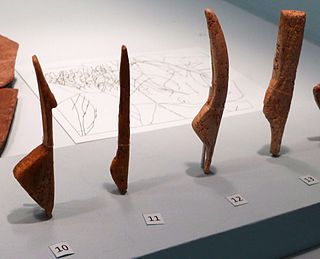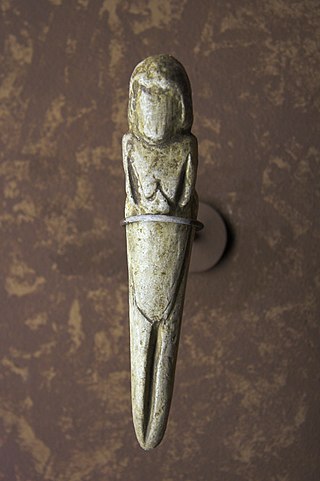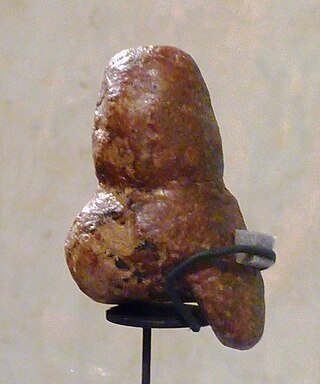
Maurice Marie Émile Leblanc was a French novelist and writer of short stories, known primarily as the creator of the fictional gentleman thief and detective Arsène Lupin, often described as a French counterpart to Arthur Conan Doyle's creation Sherlock Holmes.

A Venus figurine is any Upper Palaeolithic statue portraying a woman, usually carved in the round. Most have been unearthed in Europe, but others have been found as far away as Siberia and distributed across much of Eurasia.

The Venus of Brassempouy is a fragmentary ivory figurine from the Upper Palaeolithic, apparently broken from a larger figure at some time unknown. It was discovered in a cave at Brassempouy, France in 1894. About 25,000 years old, it is one of the earliest known realistic representations of a human face.

A statue menhir is a type of carved standing stone created during the later European Neolithic Period.

The Cave of the Trois-Frères is a cave in southwestern France famous for its cave paintings. It is located in Montesquieu-Avantès, in the Ariège département. The cave is named for three brothers, Max, Jacques, and Louis Begouën, who, along with their father Comte Henri Begouën, discovered it in 1914. The drawings of the cave were made famous in the publications of the Abbé Henri Breuil. The cave art appears to date to approximately 13,000 BC.
Pierre Bec was a French Occitan-language poet and linguist. Born in Paris, he spent his childhood in Comminges, where he learnt Occitan. He was deported to Germany between 1943 and 1945. After returning, he studied in Paris, where he graduated in 1959. He was one of the founders of the IEO or Institut d'Estudis Occitans as well as its president from 1962 to 1980.

Roc-aux-Sorciers is an Upper Paleolithic rock shelter site dating to the mid-Magdalenian cultural stage, ca 14,000 yBP, made famous by its relief wall carvings. The site is in the French commune of Angles-sur-l'Anglin, in Vienne. The name 'Sorcerers' Rock', with its suggestions of pagan rendez-vous, was applied to the site long before the wall-carvings were discovered.
Edmond Couchot was a French digital artist and art theoretician who taught at the University Paris VIII.
Tell Aswad, Su-uk-su or Shuksa, is a large prehistoric, neolithic tell, about 5 hectares (540,000 sq ft) in size, located around 48 kilometres (30 mi) from Damascus in Syria, on a tributary of the Barada River at the eastern end of the village of Jdeidet el Khass.

The Venus figurines from Gönnersdorf, at Neuwied, are paleolithic sculptures depicting the female body.

The Venus figurines of Mal’ta are several palaeolithic female figurines of the Mal'ta–Buret' culture, found in Siberia, Russia.

L'Abri Pataud, or the Pataud Shelter in English, is a prehistoric site found in the middle of the village Les Eyzies-de-Tayac-Sireuil in Dordogne, Aquitaine, southwestern France. The site includes human remains, stone tools, and early cultural artifacts made during the Upper Paleolithic, between approximately 47,000 and 17,000 years ago.
Félix Regnault was a French physician, anthropologist and prehistorian. He served as president of the Société d'Anthropologie de Paris and the Société préhistorique française (1928).

La Grotte des Fées is a cave located in Châtelperron, in the central French department of Allier.
The Venus of Savignano is a Venus figurine made from soft greenstone (serpentine) dating back to the Upper Paleolithic, which was discovered in 1925 near Savignano sul Panaro in the Province of Modena, Italy.

The Venus of Mauern is a Venus figurine from the paleolithic era. The statuette stems from the Gravettian and is about 27.000 years of age. The figurine consists of red painted limestone and was found in 1948 in Mauern (Rennertshofen). It is housed in the Archäologische Staatssammlung in Munich.

The Venus figurines of Petersfels are several small female statuettes from the Upper Paleolithic era, carved from jet lignite. The tallest figurine is called the Venus of Engen. The figurines were discovered in the Petersfels caves near Engen, Baden-Württemberg, excavated in 1927–1932 by Eduard Peters und Volker Toepfer and then in 1974–1976 and 1978 by Gerd Albrecht. They stand between 1.5 and 4 cm tall and are about 15,000 to 11,500 years old, created during the Magdalenian era. They are housed in the Museums of Freiburg im Breisgau and Engen.

The Venus figurines of Gagarino are eight Palaeolithic Venus figurines made from ivory. The statuettes belong to the Gravettian industry and are about 21,000–20,000 years old. They were discovered near to the village of Gagarino in Lipetsk Oblast, Russia, and are now held in the Hermitage Museum in Saint Petersburg.

The Venus figurines of Balzi Rossi from the caves near Grimaldi di Ventimiglia (Italy) are thirteen Paleolithic sculptures of the female body. Additionally, two small depictions of the human head were discovered at the same place. The age of these figurines cannot be determined because of missing archaeological context data. It is usually accepted that these figurines stem from the Gravettian, about 24,000 to 19,000 years old. Most of the sculptures consist of steatite and are between 2.4 and 7.5 cm in height. Between 1883 and 1895, the figurines were discovered by the antique dealer Louis Alexandre Jullien at the cave complex Balzi Rossi at the Ligurian coast. Eight of these sculptures are housed in the museum Saint-Germain-en-Laye near Paris.

The Masked Goddess is a relatively large Japanese dogū or clay figurine of the late Jōmon period. Excavated from the Nakappara Site in Chino, Nagano Prefecture, it is exhibited at the nearby Togariishi Museum of Jōmon Archaeology. Alongside the "Hollow Dogū" from Hokkaidō, the "dogū with palms pressed together" from Aomori Prefecture, "Jōmon Goddess" from Yamagata Prefecture, and "Jōmon Venus" that was also excavated in Chino, it is one of five dogū that have been designated National Treasures.















